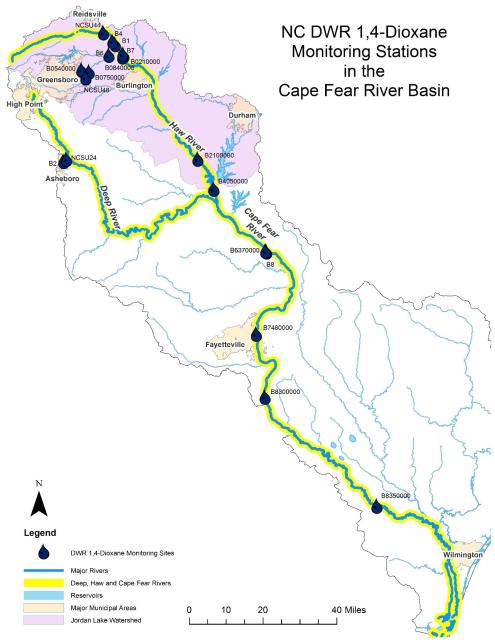Cape Fear River Basin 1,4-Dioxane Study
The U.S. Environmental Protection Agency's Third Unregulated Contaminant Monitoring Rule (UCMR 3) required public water supply systems throughout the United States to monitor for the presence of contaminants, including 1,4-dioxane, in drinking water water 2013-2015. Results of UCMR 3 monitoring indicated the presence of 1,4-dioxane in North Carolina was most prevalent within the Cape Fear River Basin. The North Carolina Department of Environmental Quality Division of Water Resources conducted follow-up stream sampling studies to better determine the concentrations of 1,4-dioxane, and their potential sources within the basin.
Results from the study's first year indicated four primary areas of elevated 1,4-dioxane in the upper portion of the Cape Fear River basin. Three of these areas were located immediately downstream of wastewater treatment plants, indicating that discharges from these facilities may be conduits for 1,4-dioxane. The fourth was located further downstream from a treatment plant. Results from the study's second year demonstrated reductions in 1,4-dioxane concentration at almost all monitoring stations.
The Division of Water Resources continues to monitor 1,4-dioxane at locations in the Cape Fear River basin, with the objectives of further understanding changes in concentrations, identifying potential sources of the compound, and documenting data that will help the state develop a regulatory strategy. Funding has recently become available to expand the study to include monitoring in the Neuse and Yadkin river basins.
Data collected from established DWR ambient water quality monitoring stations
1,4-Dioxane in the Cape Fear River Basin: An Initial Screening and Source Study
1,4-Dioxane in the Cape Fear River Basin: An Ongoing Screening, Source, and Abatement Study
1,4-Dioxane and Bromide Monitoring Plan (beginning Fall 2017)
EPA's 2018 Drinking Water Standards and Health Advisories
EPA's Third Unregulated Contaminant Monitoring Rule

